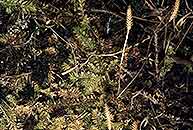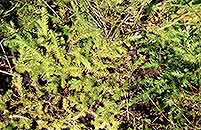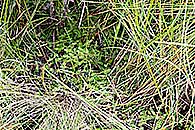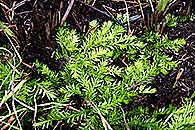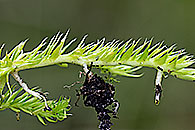Lycopodiella caroliniana (L.) Pic.Serm.
Synonyms |
Lycopodiella affinis (Bory) Pic.Serm. |
|---|---|
Common name |
|
Description |
Stem branched, creeping on the ground, rooting along its length, up to 6 mm in diameter, sometimes producing irregular pale yellowish tubers. Leaves slightly dimorphic, lanceolate to oblong or linear-lanceolate in outline, apex tapering to a point, often ± falcate; lateral leaves up to 15 x 4 mm, spreading horizontally, membranous, slightly larger than the dorsal leaves, dorsal leaves somewhat appressed to stem or curving erect. Strobili solitary, cilindrical, 15-95 × 6 mm, borne at the apex of an erect peduncle; peduncle 4-35 cm long, sparsely set with appressed, reduced leaves. Sporophylls 3.5-6 x 1.5-2 mm, yellowish, broadly ovate, tapering with a deflexed point, erose-denticulate. Sporangia 1-1.3 mm wide. |
Notes | Can be distinguished from L. sarcocaulon by having membranous lateral leaves that are of similar size or slightly larger than dorsal leaves and lance-shaped to oblong in outline. |
Derivation | caroliniana: the first specimen was collected in Carolina, United States. |
Habitat | Marshy areas, papyrus swamps, perennial or seasonal seepage zones in grassland and on wet rocks next to perennial mountain streams. |
Distribution worldwide | Africa, Madagascar, Mascarene Islands and north-eastern North America. |
Distribution in Africa |
Angola, Benin, Burkina Fasso, Burundi, Cameroon, Dem. Republic of Congo, Gabon, Guinea, Ivory Coast, Liberia, Malawi, Mali, Mozambique, Nigeria, Sierra Leone, South Africa, Tanzania , Uganda, Zambia, Zimbabwe. |
Growth form |
Lithophytic, terrestrial. |
Literature |
|
